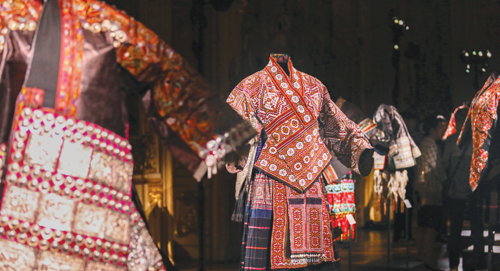

In Milan, a town in which the chic and the modern are seemingly inseparable, this was the aging star that simply stole the show: clothing dating back thousands of years gracing the catwalks and awing audiences from around the world.
That clothing, on display in the spring/summer collection of Milan Fashion Week in September, was emblazoned with intricate, ornate square patterns.
The designs were not simply inspired from the latest trends but also drew on the traditions of the Miao, who migrated across the vast expanses of ancient China, with a mission to safeguard the Miao king's seal. To preserve their identity and connection a rendering of the seal was embroidered onto their garments.
That seal has endured through centuries to find itself in the fashion spotlight, as far away as Milan, Italy.
"Miao embroidery is known as 'wearable history', and the stories of the Miao behind these designs down the centuries truly resonate with me," says Zhao Huizhou, a designer who led the Miao-inspired show in Milan.
The Miao ethnic seal features four vibrant squares, meticulously embroidered onto the chest, back and shoulders of those wearing the traditional attire. Miao communities inhabit areas across China, including in Guizhou, Yunnan, Sichuan and Guangdong provinces.
In Milan, designs were unveiled that can be traced to the distinctive attire of Miao groups in Guizhou.
The four-square seal is just one facet of Miao embroidery's narrative tapestry. Across intricate patterns, one can discern traces of the Miao migratory odyssey — through winding roads, meandering rivers and rugged terrain — all etched into the rich fabric reminiscent of the challenges their ancestors faced.
"Through these patterns Miao people record myths and epics of migration, enabling memories to be passed on down the generations," says Jiao Hongxiu, a Miao who is a local embroiderer in Kaili, Guizhou.
Liu Rui, a local official dedicated to the preservation and promotion of Miao embroidery and its culture, says embroidery serves as "a unique cultural language" for the Miao people.
"It's not merely clothing; it's a living history, a cartographic narrative and a badge of identity."
The significance of Miao embroidery includes patterns and stitching techniques in which Miao people can discern between their various communities, Liu says.
For example, a dragon motif symbolizes the Miao connection to Han Chinese culture but with subtle variations, he says. Miao groups living in Shibing county used a dragon design resembling a centipede whereas along the Bala River it took on the likeness of a silkworm.
Over thousands of years the Miao people have also traversed vast territories, from China to Southeast Asia, and later to Europe and the Americas, where they are referred to as Hmong in some areas. Official figures put the global Miao ethnic population at more than 14 million, 11 million of them in China and the rest dispersed across over 10 countries spanning four continents. Embodied in their ethnic attire, Miao culture continues in the diaspora, providing a tangible link to their ancestral heritage.